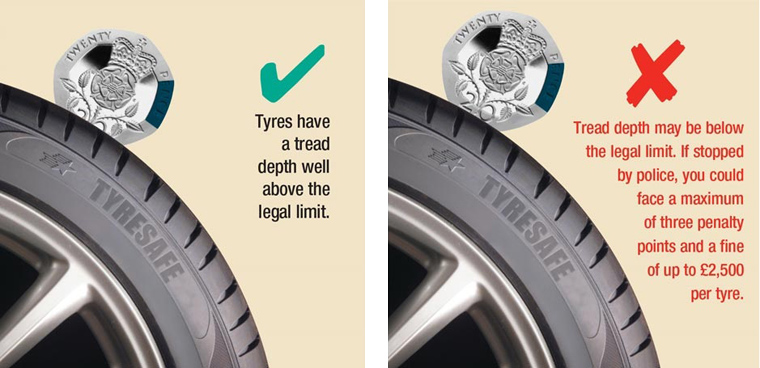John Davidge provides tyre safety advice and guidance for fleet drivers that goes well beyond winter driving to help your staff stay safe on the roads no matter the conditions.
Tyres are the only link between your vehicle and the road – that’s an area roughly equal to the sole of a size 10 shoe on each corner of the vehicle, so having the right tyres, correctly inflated and in good condition is vital for driver safety.
I’ve collected some pertinent facts and advice from my years of driver training experience for you to disseminate to staff and fleet managers to ensure that not only are staff safe on the roads, but they reduce their fuel use and reduce costs.
The Facts About Tyre Safety
Tyres carry the entire weight of your car. A load of up to 50 times their own weight (1). This is a huge burden to place upon four tyres, which is why it’s important that they are inflated correctly and are in good condition.
The legal minimum tyre tread depth in the UK and Europe is 1.6mm across the central three-quarters of the tyre. This tread must meet this requirement across the entire circumference of the tyre.
However, according to research it’s estimated that over 50% of vehicles have at least one tyre below the 1.6mm minimum legal tread depth (2).
Under-Inflated and Defective Tyres
39% of motorists are driving on under-inflated tyres which, apart from being dangerous, contribute an additional 600,000 tonnes of CO2 to the atmosphere. It’s also wasting some 244 million litres of fuel, at an estimated cost of £337 million a year (3).
1,200 road casualties and 205 fatalities were caused on Britain’s roads in 2011 as a direct result of illegal, defective or under-inflated tyres.
For each illegal or defective tyre, the potential penalty up to £2,500 and three penalty points (4).
Driving on Wet Roads
Tyre tread is for water dispersal – at 70mph, all four tyres (if new with 8mm tread depth) could be shifting three gallons (13.4 litres) of water every second. A reduced tread equals reduced water dispersal.
This causes an effect to wet braking efficiency. Wet braking efficiency is dramatically affected by tread depth. It will take 50% longer to brake from 62 to 37 mph with tyres at the legal minimum depth, compared to new tyres.
Advice for Your Fleet Drivers
Tyre Inflation Pressure
Always ensure the inflation pressure complies with the figures in the vehicle handbook. This ensures you have optimum grip, good fuel economy and the best chance of avoiding punctures.
Inflation pressures can often be found on a label in the driver door panel area and are expressed in bar [metric] or p.s.i. [imperial].
Always set your inflation pressures when the tyres are cold. After a motorway run, the tyres will have heated up, raising the inflation pressure by 0.2 – 0.4 bar.
Always replace the valve caps. This helps prevent build-up of dirt that can affect the valve.
How to Inspect Your Tyres
Every time you fill up with fuel, carry out a visual inspection of the tyre sidewalls and as much of the tread as you can see.
A popular way to test tyre tread is to use a 20p. Take a 20p coin and inset it into the grooves on the tyre, if you can’t see the outer band of the tyre, your tyres should be safe. If you can see that band get your tyres checked out by a professional as they could be unsafe.
Conduct the 20p test twice a month and before long journeys to be safe.
Common Tyre Safety Advice
It’s important to try to avoid debris in the road and potholes where possible. By looking well ahead and planning your road positioning you can avoid most serious impacts. Serious tyre damage is not always immediately apparent, so it’s make sure you see a professional if you’re unsure.
Another common effect on tyre wear is ‘dry steering’. Dry steering is the act of turning the steering wheel when stationary. Try to avoid this and only turn the steering wheel when moving.
At every service, request that the steering tracking be checked, as inaccurate tracking can cause excessive wear and handling problems.
Vibration through the steering wheel could indicate a tyre balance problem. Don’t ignore this – get a specialist to check this out before serious steering problems occur.
If you have a puncture, never attempt to replace it yourself, particularly on a motorway or dual carriageway. Call out for roadside assistance.
When Should You Replace Your Tyres?
Although the legal limit is 1.6mm of tread across three quarters of the tread width for the entire circumference, we would strongly recommend replacing tyres when they reach 3mm. This will ensure that fuel efficiency is at an optimum and that your staff stay safe.
- Michelin Tyres 2012
- Michelin Tyres 2012
- DfT Annual Statistics 2012
- DVLA Regulations




